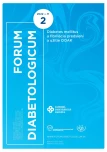Apixaban in patients with diabetes mellitus and atrial fibrillation
Authors:
Matej Samoš; Tomáš Bolek; Martin Jozef Péč; Marián Mokáň
Authors‘ workplace:
I. interná klinika JLF UK a UNM, Martin
Published in:
Forum Diab 2022; 11(2): 94-97
Category:
Overview
Apixaban is a new generation, oral, highly selective, direct and reversible inhibitor of activated coagulation factor X (FXa) which belongs to the group of direct oral anticoagulants (DOAC). Atrial fibrillation (AFib) is in patients with diabetes mellitus (DM) associated with higher risk of embolic events and long-term anticoagulation therapy is needed in majority of patients with DM and AFib to prevent these events. According to current recommendations, DOAC should be preferred for prevention of embolic events in patients with AFib. The question is whether there are currently sufficient data available regarding the efficacy and safety of apixaban therapy in patients with DM, and whether the presence of DM affects apixaban plasma levels and clinical effect of apixaban therapy. This article summarizes currently available data about the apixaban therapy in patients with DM and AFib.
Keywords:
atrial fibrillation – diabetes mellitus – apixaban – oral direct factor Xa inhibitors
Sources
1. Kubisz P, Stanciakova L, Dobrotova M et al. Apixaban – Metabolism, Pharmacologic Properties and Drug Interactions. Curr Drug Metab 2017; 18(7): 609–621. Dostupné z DOI: <http://dx.doi.org/10.2174/1389200218666170424151551>.
2. Prídavková D, Samoš M, Bolek T et al. Type 2 Diabetes, Atrial Fibrillation, and Direct Oral Anticoagulation. J Diabetes Res 2019; 2019 : 5158308. Dostupné z DOI: <http://dx.doi.org/10.1155/2019/5158308>.
3. Kirchhof P, Benussi S, Kotecha D et al. [ESC Scientific Document Group]. 2016 ESC Guidelines for the management of atrial fibrillation developed in collaboration with EACTS. Eur Heart J 2016; 37(38): 2893–2962. Dostupné z DOI: <http://dx.doi.org/10.1093/eurheartj/ehw210>.
4. Kubisz P, Stančiaková L, Dobrotová M et al. Farmakologické vlastnosti apixabanu. Vask Med 2019; 11(1): 13–18.
5. Bolek T, Samoš M, Škorňová I et al. Does proton pump inhibition change the on-treatment anti-Xa activity in xabans-treated patients with atrial fibrillation? A pilot study. J Thromb Thrombolysis 2019; 47(1): 140–145. Dostupné z DOI: <http://dx.doi.org/10.1007/s11239–018–1748–5>.
6. Škorňová I, Samoš M, Bolek T et al. Does atorvastatin therapy change the anti-Xa activity in xabans-treated patients with atrial fibrillation? Pharmacol Res Perspect 2021; 9(3): e00730. Dostupné z DOI: <http://dx.doi.org/10.1002/prp2.730>.
7. Apixaban (Eliquis®). Súhrn charakteristických vlastností lieku (Summary of Product Characteristics – SPC). Bristol – Myers Squibb/ Pfizer EEIG 2021. Dostupné z WWW: <https://www.ema.europa.eu/en/documents/product-information/eliquis-epar-product-information_sk.pdf>.
8. Samoš M, Bolek T, Stančiaková L et al. Does type 2 diabetes affect the on-treatment levels of direct oral anticoagulants in patients with atrial fibrillation? Diabetes Res Clin Pract 2018; 135 : 172–177. Dostupné z DOI: <http://dx.doi.org/10.1016/j.diabres.2017.11.024>.
9. Ezekowitz JA, Lewis BS, Lopes RD et al. Clinical outcomes of patients with diabetes and atrial fibrillation treated with apixaban: results from the ARISTOTLE trial. Eur Heart J Cardiovasc Pharmacother 2015; 1(2): 86–94. Dostupné z DOI: <http://dx.doi.org/10.1093/ehjcvp/pvu024>.
10. Lip GYH, Keshishian AV, Kang AL et al. Effectiveness and Safety of Oral Anticoagulants in Patients with Nonvalvular Atrial Fibrillation and Diabetes Mellitus. Mayo Clin Proc 2020; 95(5): 929–943. Dostupné z DOI: <http://dx.doi.org/10.1016/j.mayocp.2019.05.032>.
11. Deitelzweig S, Sah J, Kang A et al. Effectiveness and Safety of Apixaban Versus Warfarin in Obese Patients with Nonvalvular Atrial Fibrillation Enrolled in Medicare and Veteran Affairs. Am J Cardiol 2022; 163 : 43–49. Dostupné z DOI: <http://dx.doi.org/10.1016/j.amjcard.2021.09.047>.
12. Roy Chowdhury K, Michaud J, Yu OH et al. Effectiveness and safety of apixaban vs. rivaroxaban in patients with atrial fibrillation and type 2 diabetes mellitus. Thromb Haemost 2022. Online ahead of print. Dostupné z DOI: <http://dx.doi.org/10.1055/a-1798–2116>.
13. Samoš M, Stančiaková L, Škorňová I et al. Review of the Pharmacology of the Emerging Possibilities of the Direct Oral Anticoagulants’ Reversal. Curr Drug Metab 2017; 18(7): 643–650. <http://dx.doi.org/10.2174/1389200218666170413155351>.
14. Barcellona D, Mameli A, Cornacchini S et al. Patients’ adherence to oral anticoagulants therapy: Comparison between vitamin K antagonists and direct oral anticoagulants. Int J Cardiol 2021; 333 : 162–166. Dostupné z DOI: <http://dx.doi.org/10.1016/j.ijcard.2021.03.003>.
15. Brízido C, Ferreira AM, Lopes P et al. Medication adherence to direct anticoagulants in patients with non-valvular atrial fibrillation. A real world analysis. Rev Port Cardiol (Engl Ed) 2021; 40(9): 669–675.Dostupné z DOI: <http://dx.doi.org/10.1016/j.repce.2021.07.002>.
Labels
Diabetology Endocrinology Internal medicineArticle was published in
Forum Diabetologicum

2022 Issue 2
Most read in this issue
- Bleeding in patients on direct oral anticoagulants therapy: diagnostic-therapeutic management
- Laboratory monitoring of the treatment with direct oral anticoagulants
- Rivaroxaban in patients with diabetes mellitus and atrial fibrillation
- Diabetes mellitus and atrial fibrillation
